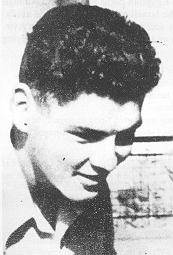 Stan Andrews
Stan Andrews Stan Andrews
Stan Andrews
New York, New York
Combat Record
Grounded July 1948
KIA October 20, 1948
Story
Stan Andrews played only a minor role in the 101 Squadron's success in the 1948-49 war but, in a small way, he had an effect on the IAF that continues to today.
Stan Andrews flew USAAF B-25s in the southwest Pacific during WWII. After the war, he attended art school in Los Angeles with his friend Bob Vickman. They felt as Jews a desire to help Israel and as artists, they wanted to record visually the birth of the new state. They brought cameras and art supplies with them from California.
Andrews and Vickman trained as part of the second wave of S-199 pilots. The two became close friends with Dov Ben Zvi.
Shortly after arriving in Israel in early June, the veteran pilots of the 101 took Andrews and the rest of the new guys out to a Tel Aviv bar. The pilots, bolstered by the squadron's first aerial victories on June 3, discussed creating a logo for the squadron. Modi Alon wanted the logo to feature a scorpion, like that of a particular RAF squadron. Mindful of the squadron's main foe, the Egyptians, Lenart remarked that it had been the angel of death who finally forced the biblical Pharoah to capitulate in the Passover story and suggested that theme.
![]() Andrews and
Vickman sketched out a first draft of an angel of death badge on a cocktail
napkin. They drew a skull wearing a flying helmet - the symbol that would soon
be painted on the left side of all the 101's S-199s. Modi Alon's scorpion design
was adopted by 105 Squadron in 1950.
Andrews and
Vickman sketched out a first draft of an angel of death badge on a cocktail
napkin. They drew a skull wearing a flying helmet - the symbol that would soon
be painted on the left side of all the 101's S-199s. Modi Alon's scorpion design
was adopted by 105 Squadron in 1950.
On July 9, Andrews was supposed to accompany Lou Lenart, Bill Pomerantz, and Bob Vickman to Al Arish, but he overturned his S-199. Lenart took off first, to be followed by Andrews. On his take-off run, Andrews slewed to the left and dug his right wingtip into the ground. The plane flipped and rested on its back. Ground crews tried to move the plane for 20 minutes while Lenart orbited the field. Finally, some local Yemenite farmers used long poles to right the plane. Vickman and Pomerantz then joined Lenart.
The detonators of the two bombs Andrews's plane had been carrying had not yet been set and the bombs did not explode. Andrews walked away from the wreck with minor head injuries.
Vickman's death that day seriously affected Andrews, who, according to Dov Ben Zvi, started "to do stupid things" which eventually led to his grounding. Ben Zvi recalled:
After he had been grounded, one of the things we had done for Stan was to promote him to Major, while he assumed the name of Stanic. As Major Stanic, he was made liaison officer to the UN forces down south....
Stan was then sent up to Ramat David as Operations officer with 69 Squadron (consisting of three B-17s). (Cull et al 1994)
Eventually, the air force promoted Andrews to major and made him the air force liason to the UN truce supervision forces in the south, for which he adopted the name Andre Stanek (or Stanic). It's not clear exactly why he used a pseudonym, but he may have done so to avoid potential legal problems with American authorities after the war.
Andrews did not respect his grounded status, although he didn't pilot any aircraft. On Oct. 19 and again on Oct. 20, he flew as an observer with 103 Squadron's Len Fitchett in Beaufighter D-171. The first of these flights would prove fantastic while the second would prove a fatal mistake.
In the afternoon of Oct. 19, Fitchett left Ramat David to take part in a naval skirmish off Majdal but before he could reach the Egyptian vessel, he encountered three Egyptian fighters: two Spitfire LF9s and a Fury. Fitchett jettisoned his ordinance and dove for the surface, maneuvering violently. The Fury moved in for a rear attack. Just before hitting the sea, Fitchett hauled back on the stick and leveled out. The Fury slammed into the sea. Its pilot, Sqn Ldr Muhammad Abd al Hamid Abu Zaid, commanding officer of 2 Sqn REAF since May 22, was considered one of the REAF's top flyers and had flown 72 sorties since May.
The next morning, Fitchett and Dan Rosin flew Israel's two Beaufighters to the Egyptian-occupied police fort at Iraq al Suweidan to soften it for an attack by the army. Ignoring orders, Fitchett made a second pass at the target and suffered a hit in the port engine. He ditched behind enemy lines and although Fitchett, Andrews, and navigator Dov Sugerman survived the landing, Egyptian soldiers shot and mutilated them.
Andrews's death affected Ben Zvi, by now base commander at Ramat David, deeply:
When I discovered that he had flown on operations in the Beaufighter, I told Danny Rosin, the CO of 103 Squadron, that Stan was not to fly in anything. But Stan ignored us and went off again. And he was shot down. All very sad.
When Stan was shot down, I had a breakdown. Bill Katz took over as CO at Ramat David and I spent a fortnight in hospital. I was then sent to Tiberias to the convalescent home there. (Cull et al 1994)
Stan Andrews didn't produce a glorious story, but a version of the 101 Squadron badge appears on a Mirage IIICJ at the IAF museum and currently adorns the squadron's F-16s.
